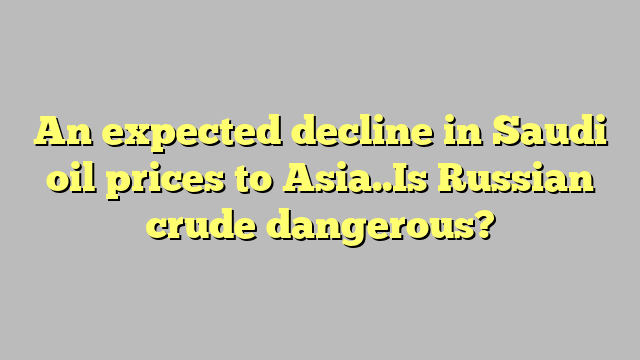It seems that the competition in the Asian markets will become more difficult, with the spread of news that Saudi oil prices may witness a decline in Asia during the month of March next.
Saudi Arabia (the largest oil exporter in the world) may resort to lowering the prices of crude grades to Asia for the fourth month in a row, with the decline in oil premiums and the increase in fears of a glut in crude supplies, despite expectations of a recovery in demand in China, according to a survey conducted by Reuters, which I reviewed. specialized power platform.
The survey showed that Saudi Aramco may reduce the official selling price of its Arab Light crude by about 30 cents to Asian customers for March shipments (2023).
This could narrow the overall difference to around $1.50 a barrel over the average pricing of Platts Dubai and Omani crude on the DME, which is the lowest since November (2021).
competition in the Asian market
The founder of the “VandaInsights” center on energy markets, Vandana Hari, believes that Aramco’s acceptance of this step represents an admission that there is competition between the Russian and Saudi oil.

And she said – in exclusive statements to the energy platform – that Russian oil is currently trading at a great discount, and has become available to Asian markets.
She added, “This step appears to be an acknowledgment that there is competition between Russian crude and Saudi barrels.”
Before Russia invaded Ukraine in February (2022), Europe was the largest market for Russian oil, but with the ban on Russian imports at the end of 2022, Russia was forced to search for alternative markets, and directed supplies to the Asian market, specifically to China and India.
For his part, Giovanni Stanovo, a commodities analyst at UBS Bank in Switzerland, explained that the official Saudi oil prices are set according to market conditions.
He said – in statements to the specialized energy platform – that this step ensures that Saudi Arabia maintains its competitiveness against other market participants.
Giovanni Stanovo believes that all current conditions point to a decline in official selling prices in Asia.
demand in Asia
Overall demand for medium crude in Asia remains weak, and Chinese consumption may not recover in the near term, according to a Reuters survey respondent.
It is expected that the demand for fuel in China, the largest oil importer, will witness a recovery, with Beijing retreating from the strict restrictions of Corona, but the path of recovery may face difficulties and challenges. Due to the high incidence of infection in the country.
Meanwhile, Unipec – the trading arm of the Chinese company Sinopec – bought supplies at low prices from Abu Dhabi, Brazil and North America during January (2023).
This step came amid expectations of a recovery in oil demand in the second quarter, after China canceled the “zero Covid” policy during 2022.

It appears that the oversupply is still overshadowing the Asian market, as China and India continue to buy cheap Russian barrels.
The European Union is scheduled to start banning imports of Russian oil derivatives starting from February 5 (2023), and this may limit Russia’s ability to refine Russian oil, and this will lead to an increase in crude oil exports.
The Organization of the Petroleum Exporting Countries (OPEC) and the OPEC+ alliance are also likely to continue adopting a policy of cutting production by two million barrels per day, amid growing fears of a global recession.
Saudi oil prices fell
Arab Medium and Heavy crude prices are expected to witness larger cuts with weak fuel oil refining margins, according to the expectations of the respondents.
The official selling prices for Saudi crude determine the direction of Iranian, Kuwaiti and Iraqi crude prices. This affects approximately 9 million barrels per day of crude oil destined for Asia.
It is noteworthy that Aramco sets Saudi oil prices according to customer recommendations, and after calculating the change in the value of its oil during the previous month, based on revenues and product prices.
Aramco had tended to reduce the official selling prices of Arab Light crude oil to Asia during the month of February (2023) to the lowest level in 15 months.
And Saudi Aramco reduced the official selling prices for Arab Light crude to Asia during January (2023), to $ 3.25 a barrel, above the average prices of the Sultanate of Oman / Dubai, down by $ 2.2 from December (2022).
related topics..
Also read..

Leave a Reply